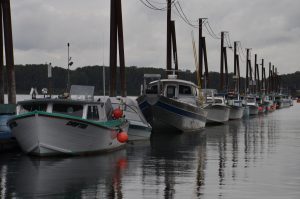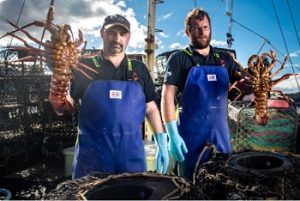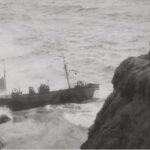Monthly Archives: October 2016
A Rare Albino Haddock!
 Fishermen have landed an extremely rare ‘albino’ haddock at estimated odds of one in 100,000,000. The incredible catch was made about 45 miles north of Unst — the most northerly inhabited island in Britain — on the weekend. And it has now been put in a freezer by scientists who want to preserve it for future research. The haddock was caught by the local fishing boat Resilient (LK 195) and taken to a fish market in Lerwick, Shetland. It was picked up by marine experts from the University of the Highlands and Islands who said they had never come across anything like it. Leanna Henderson, a marine technician at the university’s NAFC marine centre, said the ‘golden’ haddock had no pigment in its skin. Read the story here 10:54
Fishermen have landed an extremely rare ‘albino’ haddock at estimated odds of one in 100,000,000. The incredible catch was made about 45 miles north of Unst — the most northerly inhabited island in Britain — on the weekend. And it has now been put in a freezer by scientists who want to preserve it for future research. The haddock was caught by the local fishing boat Resilient (LK 195) and taken to a fish market in Lerwick, Shetland. It was picked up by marine experts from the University of the Highlands and Islands who said they had never come across anything like it. Leanna Henderson, a marine technician at the university’s NAFC marine centre, said the ‘golden’ haddock had no pigment in its skin. Read the story here 10:54

How a national craze caused lobster prices to boil over
The coast-to-coast craze of lobster roll food trucks has made lobster more affordable, and abroad the appetite for the crustaceans is growing as well, experts say.”The demand for this product now is really unprecedented,” said Annie Tselikis, marketing director for Maine Coast Co., a live lobster wholesaler based in York, Maine. She spoke Monday just before boarding a flight for a seafood trade show in South Korea, a major customer of North American lobsters along with China and others. According to John Sackton, one of the chief reasons prices are so high in August, September and October is “because the processors are buying lobster for customers such as lobster roll trucks, competing with the live lobster buyers. And that’s pushed up the price for lobster overall.” As a result, fresh lobster meals at some well-known Boston seafood restaurants are going nearly $60 for the 2- or 2.5-pound lobster and about $44 for the 1.25-pound. In Maine, lobster dinners at fine dining locations can set you back around $50, and in New York City and California you’re looking at upward of $70. Read the rest here 10:31
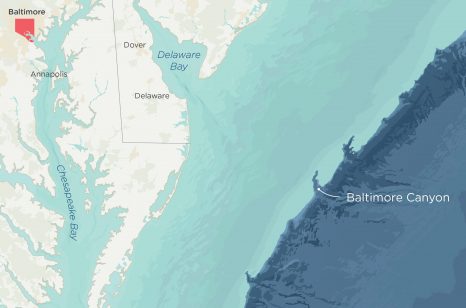
Nations 1st Urban Sanctuary Designation Sought For Popular Offshore Fishing area, Baltimore Canyon
The National Aquarium on Monday announced it is seeking the public’s support in its effort to nominate the Baltimore Canyon off the coast of Ocean City as the nation’s first Urban National Marine Sanctuary. The Baltimore Canyon, a 28-mile long and five-mile wide submarine canyon off the coast of Ocean City lies at the center of the resort’s multi-million dollar fishing industry and contains fragile deep sea corals rarely seen anywhere in the world along with habitat for countless species of marine life. The National Aquarium has launched a petition drive to have it designated as the nation’s first Urban National Marine Sanctuary, presenting a unique opportunity to connect an urban population to the ecological treasure using cutting edge deep sea exploration technology. While an Urban National Marine Sanctuary designation for the Baltimore Canyon does not appear to impact fishing and other recreational uses, it certainly bears monitoring. Earlier this fall, the Obama administration designated a vast area the size of Connecticut off the coast of Cape Cod as the Northeast Canyons and Seamounts Marine National Monument, the first of its kind in the Atlantic. Marine National Monuments are far more restrictive than national marine sanctuaries. The long-range plan is to phase out all commercial fishing in the marine national monument off the coast of Cape Cod although recreational fishing will still be allowed. Read the story here 08:48
KAELIN: Fisheries commission should increase menhaden quota
 When Thanksgiving rolls around this year, the Atlantic States Marine Fisheries Commission may give New Jersey’s fishermen something to be thankful for. At its meeting Wednesday, the ASMFC will be voting on whether to increase the number of menhaden fishermen can catch each year. By voting in favor of a quota increase, which is strongly supported by the science New Jersey’s commission representatives can improve local economies and bolster the bottom line of hard-working fishermen during the summer and fall seasons while maintaining a balanced ocean ecosystem. After the release of a periodic stock assessment in 2012, the ASMFC incorrectly concluded the stock was threatened. The commission followed that assessment with a significant cut in the amount of menhaden New Jersey fishermen were allowed to catch — a cut of more than 50 percent that remains in effect today, much to the detriment of New Jersey fishing businesses. Read the story here 19:57
When Thanksgiving rolls around this year, the Atlantic States Marine Fisheries Commission may give New Jersey’s fishermen something to be thankful for. At its meeting Wednesday, the ASMFC will be voting on whether to increase the number of menhaden fishermen can catch each year. By voting in favor of a quota increase, which is strongly supported by the science New Jersey’s commission representatives can improve local economies and bolster the bottom line of hard-working fishermen during the summer and fall seasons while maintaining a balanced ocean ecosystem. After the release of a periodic stock assessment in 2012, the ASMFC incorrectly concluded the stock was threatened. The commission followed that assessment with a significant cut in the amount of menhaden New Jersey fishermen were allowed to catch — a cut of more than 50 percent that remains in effect today, much to the detriment of New Jersey fishing businesses. Read the story here 19:57
Latest report says menhaden thriving in the Gulf
 A commission that assesses the health and viability of the menhaden population in the Gulf released a report this week that says despite massive commercial hauls, the menhaden population is sound. It’s called a stock assessment for menhaden — a fish caught for catfood and fish oil supplements and a favorite food of large game fish. If fact, there’s been controversy this year over how many redfish commercial menhaden boats in the Gulf should be allowed to keep in the bycatch while fishing for menhaden. Gulf States Marine Fisheries Commission evaluated the status of the Gulf menhaden in U.S. waters and concluded the “Gulf of Mexico’s menhaden stock is not experiencing overfishing,” said Steven J. VanderKooy, a fisheries coordinator with the commission, which has an Ocean Springs office. Read the story here 19:42
A commission that assesses the health and viability of the menhaden population in the Gulf released a report this week that says despite massive commercial hauls, the menhaden population is sound. It’s called a stock assessment for menhaden — a fish caught for catfood and fish oil supplements and a favorite food of large game fish. If fact, there’s been controversy this year over how many redfish commercial menhaden boats in the Gulf should be allowed to keep in the bycatch while fishing for menhaden. Gulf States Marine Fisheries Commission evaluated the status of the Gulf menhaden in U.S. waters and concluded the “Gulf of Mexico’s menhaden stock is not experiencing overfishing,” said Steven J. VanderKooy, a fisheries coordinator with the commission, which has an Ocean Springs office. Read the story here 19:42
Taranaki fisherman slams government data on Maui’s dolphin
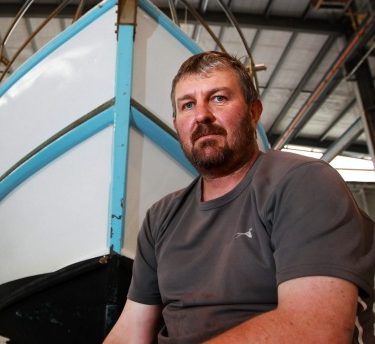 A commercial fisherman in Taranaki has rubbished new government data which shows increased Maui’s dolphin numbers. The research – conducted by the Department of Conservation and the Ministry of Primary Industries – found there are approximately 63 adults left in the species whereas there was previously thought to have been only 55. New Plymouth fisherman Rob Ansley said claims by minister Nathan Guy that set net restrictions were having a positive effect on Maui’s numbers was “a load of s**t”. Ansley said government observers aboard fishing boats in Taranaki waters had not seen a single Maui’s dolphin since they started observing in 2012. “How can it be working if no one has ever had a confirmed sighting of these dolphins,” he said. According to the Department of Conservation the last confirmed sighting of a Maui’s dolphin in Taranaki was at Port Taranaki on January 18, 2014 while the last sighting in New Zealand was on March 20, 2016 off Muriwai beach in Auckland. Read the story here 15:28
A commercial fisherman in Taranaki has rubbished new government data which shows increased Maui’s dolphin numbers. The research – conducted by the Department of Conservation and the Ministry of Primary Industries – found there are approximately 63 adults left in the species whereas there was previously thought to have been only 55. New Plymouth fisherman Rob Ansley said claims by minister Nathan Guy that set net restrictions were having a positive effect on Maui’s numbers was “a load of s**t”. Ansley said government observers aboard fishing boats in Taranaki waters had not seen a single Maui’s dolphin since they started observing in 2012. “How can it be working if no one has ever had a confirmed sighting of these dolphins,” he said. According to the Department of Conservation the last confirmed sighting of a Maui’s dolphin in Taranaki was at Port Taranaki on January 18, 2014 while the last sighting in New Zealand was on March 20, 2016 off Muriwai beach in Auckland. Read the story here 15:28
Fishing chiefs to meet Scottish Government over Brexit
 Scottish fishing leaders will hold meetings with key Government representatives this week to promote the opportunities they believe Brexit can deliver for Scotland’s coastal communities. Bertie Armstrong, chief executive of the Scottish Fishermen’s Federation, will give evidence tomorrow to the House of Commons Scottish Affairs Committee in Glasgow to outline how he believes Brexit, if handled properly, could provide the framework for injecting fresh dynamism into Britain’s fishing communities. “But to achieve this, we need our politicians to be fully onside so that fishing is right at the heart of the Brexit process.“We will be telling UK and Scottish Government ministers that it would be unforgivable if fishing was traded away during the negotiations. Read the story here 14:28
Scottish fishing leaders will hold meetings with key Government representatives this week to promote the opportunities they believe Brexit can deliver for Scotland’s coastal communities. Bertie Armstrong, chief executive of the Scottish Fishermen’s Federation, will give evidence tomorrow to the House of Commons Scottish Affairs Committee in Glasgow to outline how he believes Brexit, if handled properly, could provide the framework for injecting fresh dynamism into Britain’s fishing communities. “But to achieve this, we need our politicians to be fully onside so that fishing is right at the heart of the Brexit process.“We will be telling UK and Scottish Government ministers that it would be unforgivable if fishing was traded away during the negotiations. Read the story here 14:28
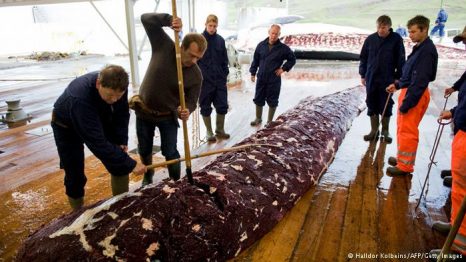
Controversial whale sanctuary to be voted on at the International Whaling Commission
A whale sanctuary in the South Atlantic covering an area as big as India and Russia together: This is the proposal presented by Argentina, Gabon, South Africa, Uruguay and Brazil at the 65th meeting of the International Whaling Commission in Slovenia, which runs from October 20 to 28. A heated debate between some 80 pro- and anti-whaling nations will lead tomorrow (25.10.2016) into voting on whether to give the green light to the proposal, or reject it once again – it happened in 1998. Japan, Iceland and Norway have been the three main countries blocking the sanctuary due – environmentalists say – to their commercial interests. These three nations have used legal loopholes and controversial arguments to keep hunting whales, even in existing sanctuaries. If the new sanctuary proposal is accepted, the immediate question following the hurrahs will be how to really protect whales there from countries that continue to insist on whaling. While the moratorium for commercial hunting from 1985 largely improved the protection of whales, threats such as by-catch or pollution were left out of the agreement. Whale sanctuaries are intended to fill that gap. Read the story here 13:12
Atlantic States Marine Fisheries Commission meeting at Bar Harbor, Maine October 24th-27th – Listen Live
 The Atlantic States Marine Fisheries Commission will meet in at the Harborside Hotel 55 West Street Bar Harbor, Maine. The agenda is subject to change. The agenda reflects the current estimate of time required for scheduled Board meetings. The Commission may adjust this agenda in accordance with the actual duration of Board meetings. Interested parties should anticipate Boards starting earlier or later than indicated herein. Click here for details, Click here for webinar 12:10
The Atlantic States Marine Fisheries Commission will meet in at the Harborside Hotel 55 West Street Bar Harbor, Maine. The agenda is subject to change. The agenda reflects the current estimate of time required for scheduled Board meetings. The Commission may adjust this agenda in accordance with the actual duration of Board meetings. Interested parties should anticipate Boards starting earlier or later than indicated herein. Click here for details, Click here for webinar 12:10
‘He bit me’ – Digby lobster fisherman catches strange fish
 Glen Oliver, first mate on the/Randi & Brianne , was hauling traps in the middle of the Annapolis Basin Oct. 22 when he saw something he’d never seen before. He hollered to captain Ralph Cummings to take a look. In the parlour of the trap, along with a couple lobster, was a fish Cummings had never seen before. “I’ve been fishing for 30 year and I’ve never seen one,” he said. “I took a picture and sent it to Johnny. I knew he could figure it out.” Cummings is used to fish in the traps – it’s not at all unusual to find codfish, sculpins or toadfish in the parlour. But this was different. Cummings had caught a grey triggerfish (Balistes capriscus) about a foot and half long with a deep body, tough leathery scales, eyes set back and high up on the body and a little beak-like mouth. Cummings learned the hard way that inside the little mouth are two rows of sharp teeth. “He bit me. I guess I had my hand too close to his mouth,” he said. Read the story here with two more images 11:41
Glen Oliver, first mate on the/Randi & Brianne , was hauling traps in the middle of the Annapolis Basin Oct. 22 when he saw something he’d never seen before. He hollered to captain Ralph Cummings to take a look. In the parlour of the trap, along with a couple lobster, was a fish Cummings had never seen before. “I’ve been fishing for 30 year and I’ve never seen one,” he said. “I took a picture and sent it to Johnny. I knew he could figure it out.” Cummings is used to fish in the traps – it’s not at all unusual to find codfish, sculpins or toadfish in the parlour. But this was different. Cummings had caught a grey triggerfish (Balistes capriscus) about a foot and half long with a deep body, tough leathery scales, eyes set back and high up on the body and a little beak-like mouth. Cummings learned the hard way that inside the little mouth are two rows of sharp teeth. “He bit me. I guess I had my hand too close to his mouth,” he said. Read the story here with two more images 11:41

CETA is OVER: Belgian PM kills trade deal in devastating blow to EU
Charles Michel said after a meeting with regional leaders: “I have officially told Tusk that we have no agreement.” The EU had given Belgium until Monday to overcome opposition to the CETA trade deal from its French-speaking south before it would likely have to cancel a Thursday summit with Canadian Prime Minister Justin Trudeau to sign the pact. Mr Michel said he was still open to dialogue with the main holdout, the region of Wallonia, and that it was too early to say whether CETA was dead.EU and Canadian leaders have said they are keen to conclude the deal after years of negotiation. Mr Michel could not provide the consent of Belgium to that of the other 27 EU member states without backing from five regional authorities. Read the rest here 11:11
The Race to Spread the EDF IFQ Recreational Fishery Propaganda.
 Gulf fisheries were in dire condition before the Environmental Defense Fund teamed with local fishermen across the Gulf, from Florida to Texas, to help turn things around. In those days, fishermen were stuck under failing management that perpetuated overfishing and reduced the population of Gulf red snapper to just 4 percent of its historic level. Due to misguided and ineffective rules, the commercial fleet was in a derby system — a race to catch fish that was dangerous and destructive to both fish and fishermen’s businesses. The catch limits that were put in place to solve the problem were not working. Seeing their livelihoods collapsing under failing management, commercial fishermen voted twice, in supermajorities, to implement a system known as catch shares or individual fishing quotas, which went on the water in 2007. EDF is proud to have worked with our fishing partners on this system. Read the story here 10:22
Gulf fisheries were in dire condition before the Environmental Defense Fund teamed with local fishermen across the Gulf, from Florida to Texas, to help turn things around. In those days, fishermen were stuck under failing management that perpetuated overfishing and reduced the population of Gulf red snapper to just 4 percent of its historic level. Due to misguided and ineffective rules, the commercial fleet was in a derby system — a race to catch fish that was dangerous and destructive to both fish and fishermen’s businesses. The catch limits that were put in place to solve the problem were not working. Seeing their livelihoods collapsing under failing management, commercial fishermen voted twice, in supermajorities, to implement a system known as catch shares or individual fishing quotas, which went on the water in 2007. EDF is proud to have worked with our fishing partners on this system. Read the story here 10:22

New turbines just as lethal as Annapolis turbines
Much more needs to be said and written about the testing of tidal stream turbines in Minas Passage. Graham Daborn, emeritus professor at Acadia University, wrote an Opinions article under this heading (Oct. 15), but without the “more”. Unfortunately much of what has been said and written comes from the proponents of tidal power. And they have obscured the facts about what the physical properties of their machines can do to living organisms. People living around Minas Basin still talk about what happened when the first turbine was installed at the FORCE (Fundy Ocean Research Center for Energy) experimental site in 2009. Two humpback whales suddenly showed up on Minas Basin beaches with large gashes in their bodies. That turbine suddenly stopped working and when it was lifted in 2010 blades were broken. What broke them? Annapolis was installed as a test turbine and 31 years later it is still spinning, still killing fish (five sturgeon and counting this year). There never was an environmental assessment. Read the op-ed here 09:43
Rock shrimp fishing pioneer Rodney Thompson passes away
 During his long career, he founded T-Craft Boats, Thompson Trawlers, Offshore 30, Thompson Industries, Sand Point Inn, Pelican Point Inn, Ponce Seafood, Dixie Crossroads Seafood Restaurant, Cape Canaveral Shrimp Company and Wild Ocean Seafood Market. Rock shrimp fishing was his claim to fame, with his family following in his footsteps. “Prior to our family getting involved with rock shrimp, they were considered a trash item. Because their shell was so hard, no one was interested in buying them. The conventional mechanical peelers that were used to peel white shrimp, brown shrimp, they would not work on the shell of the rock shrimp,” said Laurilee Thompson, Rodney’s daughter. She now co-owns Dixie Crossroads Seafood Restaurant. Read the rest here 20:17
During his long career, he founded T-Craft Boats, Thompson Trawlers, Offshore 30, Thompson Industries, Sand Point Inn, Pelican Point Inn, Ponce Seafood, Dixie Crossroads Seafood Restaurant, Cape Canaveral Shrimp Company and Wild Ocean Seafood Market. Rock shrimp fishing was his claim to fame, with his family following in his footsteps. “Prior to our family getting involved with rock shrimp, they were considered a trash item. Because their shell was so hard, no one was interested in buying them. The conventional mechanical peelers that were used to peel white shrimp, brown shrimp, they would not work on the shell of the rock shrimp,” said Laurilee Thompson, Rodney’s daughter. She now co-owns Dixie Crossroads Seafood Restaurant. Read the rest here 20:17

Global Cooling? Stronger-Than-Expected La Niña May Be Brewing
Many have doubted forecasts calling for the onset of the first La Niña in almost five years, believing that its failure to materialize in convincing fashion last summer – as originally predicted – means that it may be off the table for 2016-17. But in recent weeks, the oceans and atmosphere have been pulling everything into place to facilitate a potentially stronger La Niña than previously thought, so those who follow commodities markets may want to take a second look. Cooling sea surface temperatures in the key Niño 3.4 region have touched the levels of early 2012. –Karen Braun, Reuters, 20 October 2016 Read the rest here 14:39

Coast Guard rescues fisherman near Westport Marina in Grays Harbor, Wash.
Michael Carroll, 70, was rescued by a Station Grays Harbor boatcrew, aboard a 47-foot Motor Life Boat, and transferred to emergency medical services at the Westport Marina and was treated for symptoms related to hypothermia while being transported to Grays Harbor Community Hospital. A watchstander at Coast Guard Sector Columbia River, in Warrenton, Oregon, received a mayday call from the captain of the fishing vessel Pacific Rim at 3:51 a.m., reporting the vessel was taking on water and listing hard to starboard. The watchstander immediately directed the launch of a MLB crew. Carroll was rescued at about 4:15 a.m. The Pacific Rim is a 60-foot fishing vessel homeported in Westport. At the time of the sinking the Pacific Rim had 250 gallons of diesel fuel on board. Pollution responders from the Incident Management Division at Sector Columbia River are responding. A more thorough survey of the scene will begin at first light. Link 12:38
FFAW president hopes Canada-EU trade talks aren’t finished
 The head of Newfoundland and Labrador’s largest private-sector union said he’s disappointed that Canada-EU trade talks have fallen apart. “It’s preliminary, but it doesn’t certainly look good for (the Comprehensive Economic and Trade Agreement) in its current form right now,” Keith Sullivan, president of the Fish, Food and Allied Workers union told CBC on Friday. International Trade Minister Chrystia Freeland walked out of talks Friday with the regional government of Wallonia, which has been blocking the deal, due to be signed next week. Sullivan told CBC the deal as it stood was a “mixed bag” for Canadian workers, but he thought there was potential benefit for the fishing industry. “There was certainly an area where people saw some opportunities where they could get decreased tariffs on some products like shrimp and crab, and that was an opportunity for some people,” he said. “So it was certainly mixed, but it might be all for nothing now.” Read the rest here 12:09
The head of Newfoundland and Labrador’s largest private-sector union said he’s disappointed that Canada-EU trade talks have fallen apart. “It’s preliminary, but it doesn’t certainly look good for (the Comprehensive Economic and Trade Agreement) in its current form right now,” Keith Sullivan, president of the Fish, Food and Allied Workers union told CBC on Friday. International Trade Minister Chrystia Freeland walked out of talks Friday with the regional government of Wallonia, which has been blocking the deal, due to be signed next week. Sullivan told CBC the deal as it stood was a “mixed bag” for Canadian workers, but he thought there was potential benefit for the fishing industry. “There was certainly an area where people saw some opportunities where they could get decreased tariffs on some products like shrimp and crab, and that was an opportunity for some people,” he said. “So it was certainly mixed, but it might be all for nothing now.” Read the rest here 12:09
Coast Guard Medevacs Fisherman Off Hatteras Inlet, NC
 The Coast Guard medevaced a man Saturday from a fishing vessel off Hatteras Inlet. Watchstanders in the Coast Guard Sector North Carolina command center in Wilmington received a call from the 73-foot commercial fishing vessel Capt Alex at about 8:47 p.m., reporting the vessel’s captain was experiencing severe chest pains approximately six miles east of Hatteras Inlet. An MH-60 Jayhawk helicopter crew launched from Air Station Elizabeth City at about 9:44 p.m. The aircrew arrived on scene at approximately 10:13 p.m. and lowered a rescue swimmer to the boat. The patient was hoisted from the boat to the helicopter in a rescue basket at about 11 p.m., and flown to Sentara Norfolk General Hospital in Norfolk, Virginia, arriving at about 12:29 a.m. Link Video here 11:06
The Coast Guard medevaced a man Saturday from a fishing vessel off Hatteras Inlet. Watchstanders in the Coast Guard Sector North Carolina command center in Wilmington received a call from the 73-foot commercial fishing vessel Capt Alex at about 8:47 p.m., reporting the vessel’s captain was experiencing severe chest pains approximately six miles east of Hatteras Inlet. An MH-60 Jayhawk helicopter crew launched from Air Station Elizabeth City at about 9:44 p.m. The aircrew arrived on scene at approximately 10:13 p.m. and lowered a rescue swimmer to the boat. The patient was hoisted from the boat to the helicopter in a rescue basket at about 11 p.m., and flown to Sentara Norfolk General Hospital in Norfolk, Virginia, arriving at about 12:29 a.m. Link Video here 11:06

Norwegian whaling – based on a balanced ecosystem
Minke whales have been hunted along the coast of Norway at least since medieval times. In the 1920s, the use of harpoon gun mounted on an ordinary fishing vessel replaced aboriginal methods. The whale meat is used for consumption, primarily on the domestic market. Minke whaling today is a small scale costal activity and is carried out by vessels of between 40 and 80 feet in length with a crew of four to eight people. The home harbours of most whaling vessels are small fishing communities, and whaling in combination with fishing has contributed significantly to the economic and social development or rural, coastal communities in Norway. Norwegian whaling is based on the principle of protection and sustainable harvesting of marine resources. Management of resources is founded on scientific advice, with the objective based on the concept of an ecosystem approach. Quotas are set on the basis of procedures developed by the Scientific Committee of the International Whaling Commission (IWC). This committee has estimated that the stocks of minke whale that we harvest in the Northeast Atlantic and around Jan Mayen total 108 thousand animals For 2013, a quota is set of 1286 animals.. This is the same as the quota for 2010-2012. The stock of minke whales off Iceland and the Faeroe Islands, the central Atlantic stock, is estimated to number 71 thousand animals. Read the story here 10:02
Lost men will be remembered with a bell
 ON THE edge of the water at the Bundaberg Port stands a bell. It is a memorial for Matt Roberts and David Chivers, the same bell that would have been rung on the Cassandra. On Saturday, more than 100 people gathered to remember the men. Richard Brown, general manager of Markwell Fisheries which owned the trawler, said the company donated the bell so family, friends and fellow fishermen could have a place to pay their respects. “One of the hard things in this situation, when you talk about someone lost at sea, is there is no closure,” Mr Brown said. “The idea behind it is to give the family some kind of closure, which I think we achieved – the families were very pleased.” The bell is a symbol of boats and fishing, “a passion for both the boys”. “It’s not often everyone gets to gather together, and for the fishing industry to come together; a lot of stories and memories come out. Read the story here 09:12 Massive air and sea search near Fraser Island for missing prawn trawler “Cassandra” fishermen click here 09:21
ON THE edge of the water at the Bundaberg Port stands a bell. It is a memorial for Matt Roberts and David Chivers, the same bell that would have been rung on the Cassandra. On Saturday, more than 100 people gathered to remember the men. Richard Brown, general manager of Markwell Fisheries which owned the trawler, said the company donated the bell so family, friends and fellow fishermen could have a place to pay their respects. “One of the hard things in this situation, when you talk about someone lost at sea, is there is no closure,” Mr Brown said. “The idea behind it is to give the family some kind of closure, which I think we achieved – the families were very pleased.” The bell is a symbol of boats and fishing, “a passion for both the boys”. “It’s not often everyone gets to gather together, and for the fishing industry to come together; a lot of stories and memories come out. Read the story here 09:12 Massive air and sea search near Fraser Island for missing prawn trawler “Cassandra” fishermen click here 09:21
Santa Cruz teen brothers start Point Fish Co.
 Weekends usually mean sleeping in, but for not the Hofmann brothers of Santa Cruz. The teen entrepreneurs wake up while it’s still dark and head out for a long day of fishing. Their company, the Point Fish Co., has been in the works for years, but only recently came to fruition. The reason for the wait? The oldest brother had to wait until he was turned 16 to pilot a boat legally. The Hofmann brothers, Hayden (now 17), Baylor, 14, and 13-year-old Grady grew up around the water and always loved fishing. About six years ago they were fishing and started wondering how much money they might make if they sold their catch. When Hayden was old enough to captain the boat, the brothers decided to get some advice and researched how to start a fishing business. Read the story here 18:32
Weekends usually mean sleeping in, but for not the Hofmann brothers of Santa Cruz. The teen entrepreneurs wake up while it’s still dark and head out for a long day of fishing. Their company, the Point Fish Co., has been in the works for years, but only recently came to fruition. The reason for the wait? The oldest brother had to wait until he was turned 16 to pilot a boat legally. The Hofmann brothers, Hayden (now 17), Baylor, 14, and 13-year-old Grady grew up around the water and always loved fishing. About six years ago they were fishing and started wondering how much money they might make if they sold their catch. When Hayden was old enough to captain the boat, the brothers decided to get some advice and researched how to start a fishing business. Read the story here 18:32
Alaska dipnetting – Disorderly and unsafe
 The winter meeting of the Alaska Board of Fisheries is months away but already the weirdness has begun. At a work session in Kenai-Soldotna this week, the board spent some time kicking around the idea of motor restrictions for the Kenai River to make the popular, personal-use dipnet fishery there safer. The suggestion was brought to the board by 72-year-old Soldotna resident George Parks and picked up by the board’s new vice-chair Sue Jeffery, who termed the Kenai a “disorderly, unsafe fishery.” A commercial fisherman from Kodiak, Jeffery appeared unaware everyone was discussing the wrong fishery. There are deadly dipnet fisheries in Alaska, but the Kenai boat fishery is not one of them. The short stretch of the Kenai open to dipnetting from boats during the short July dipnet seasons does get congested. Some boats have collided, and a few have even taken on water until they sank. But no one has ever died. Read the story here 14:38
The winter meeting of the Alaska Board of Fisheries is months away but already the weirdness has begun. At a work session in Kenai-Soldotna this week, the board spent some time kicking around the idea of motor restrictions for the Kenai River to make the popular, personal-use dipnet fishery there safer. The suggestion was brought to the board by 72-year-old Soldotna resident George Parks and picked up by the board’s new vice-chair Sue Jeffery, who termed the Kenai a “disorderly, unsafe fishery.” A commercial fisherman from Kodiak, Jeffery appeared unaware everyone was discussing the wrong fishery. There are deadly dipnet fisheries in Alaska, but the Kenai boat fishery is not one of them. The short stretch of the Kenai open to dipnetting from boats during the short July dipnet seasons does get congested. Some boats have collided, and a few have even taken on water until they sank. But no one has ever died. Read the story here 14:38
Editorial: Auditor General scrutinizes DFO’s fish stock management
 In a province that has the Pacific Salmon as an official emblem, it’s surprising that a report from the federal Auditor General on the management of fish stocks by the Department of Fisheries and Oceans didn’t get more attention. The audit, conducted by the Commissioner of the Environment and Sustainable Development (part of the Auditor General’s office), disclosed a number of deficiencies that should have raised concerns, if not alarm. For example, it found only three of 15 critically depleted stocks had rebuilding plans, increasing the risk that depleted stocks won’t recover. Moreover, of 154 fish stocks, 44 were either missing integrated fish management plans or the plans were out of date. Among other problems the audit identified, third-party observers hired by fishing companies sometimes failed to comply with program requirements but DFO had little recourse other than revoking their designation, which would have deprived it of catch data. Read the op-ed here 13:21
In a province that has the Pacific Salmon as an official emblem, it’s surprising that a report from the federal Auditor General on the management of fish stocks by the Department of Fisheries and Oceans didn’t get more attention. The audit, conducted by the Commissioner of the Environment and Sustainable Development (part of the Auditor General’s office), disclosed a number of deficiencies that should have raised concerns, if not alarm. For example, it found only three of 15 critically depleted stocks had rebuilding plans, increasing the risk that depleted stocks won’t recover. Moreover, of 154 fish stocks, 44 were either missing integrated fish management plans or the plans were out of date. Among other problems the audit identified, third-party observers hired by fishing companies sometimes failed to comply with program requirements but DFO had little recourse other than revoking their designation, which would have deprived it of catch data. Read the op-ed here 13:21

Officials say they cannot enforce Hawaii fishing contracts
Federal officials cannot enforce a contract being proposed by the commercial fishing industry as a solution to concerns about foreign fishing crews in Hawaii, leaving the industry responsible for enforcing its own rules. Federal and state officials met with vessel owners, captains and representatives from the fleet Thursday at a pier in Honolulu. The normally private quarterly meeting was opened to media and lawmakers to discuss conditions uncovered in an Associated Press investigation that found some foreign fishermen had been confined to vessels for years. On Wednesday, Hawaii state Rep. Kaniela Ing held a public meeting at the state Capitol on the issue. Ing and other lawmakers pressed representatives from the fishing industry and government agencies about what can be done to increase oversight and improve conditions in the industry. Read the story here 09:31
Letter: Fisherfolk should get behind new union by Oswan Tucker, Reef’s Harbour
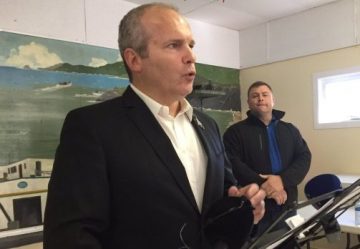 Now is the time to finish what we started last year, which was to get rid of the FFAW. The Fish, Food and Allied Workers union has neglected us, taken advantage of us and turned fisherfolk against one another. It shouldn’t be like that. We can do better than that, and now we will. We have acquired Ryan Cleary to head up our new union, which will be named the Federation of Independent Sea Harvesters of Newfoundland and Labrador (FISH-NL). This new union will look after the best interests of Newfoundland and Labrador fishermen and women — and only them. It will have a constitution drawn up to protect fisher folk from the kind of things we had to put up with from the FFAW. Read the rest here 09:06
Now is the time to finish what we started last year, which was to get rid of the FFAW. The Fish, Food and Allied Workers union has neglected us, taken advantage of us and turned fisherfolk against one another. It shouldn’t be like that. We can do better than that, and now we will. We have acquired Ryan Cleary to head up our new union, which will be named the Federation of Independent Sea Harvesters of Newfoundland and Labrador (FISH-NL). This new union will look after the best interests of Newfoundland and Labrador fishermen and women — and only them. It will have a constitution drawn up to protect fisher folk from the kind of things we had to put up with from the FFAW. Read the rest here 09:06
Scientists Are Closer To Understanding What Makes Ocean’s Toxic Algae Bloom
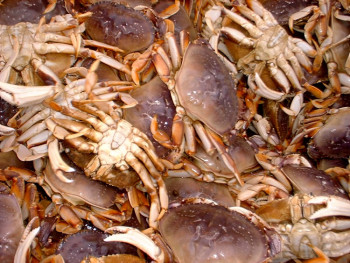 Last winter was the first time the Dungeness crab fishery in Oregon closed temporarily because of toxic algae in the ocean. And even just a week ago, another toxic bloom was happening off the coast. Scientists are just beginning to understand what triggers these conditions. A study this month from Oregon State University and the National Oceanic and Atmospheric Administration provides a rare peak below the waves. The toxin, demoic acid, is sometimes produced by an algae called Pseudo-nitzschia, or PN. PN does better than most algae when ocean temperatures are high and there isn’t much nutrients in the water. When these nutrient-poor conditions are followed by upwelling of rich, cold water from the ocean bottom, the PN are in the perfect position to party. Their numbers explode. Read the story here 08:46
Last winter was the first time the Dungeness crab fishery in Oregon closed temporarily because of toxic algae in the ocean. And even just a week ago, another toxic bloom was happening off the coast. Scientists are just beginning to understand what triggers these conditions. A study this month from Oregon State University and the National Oceanic and Atmospheric Administration provides a rare peak below the waves. The toxin, demoic acid, is sometimes produced by an algae called Pseudo-nitzschia, or PN. PN does better than most algae when ocean temperatures are high and there isn’t much nutrients in the water. When these nutrient-poor conditions are followed by upwelling of rich, cold water from the ocean bottom, the PN are in the perfect position to party. Their numbers explode. Read the story here 08:46
Whalers in crosshairs at International Whaling Commission huddle
 More than 80 nations square off in Slovenia next week over the fate of the world’s remaining whales, facing a multitude of perils from meat hunters and ship strikes to getting snared in fishing gear. The stage is set for heated debate, as the 88 members of the International Whaling Commission (IWC) are deeply divided along pro- and anti-hunting lines. The biggest bones of contention are Japan’s yearly whale hunt in the name of science, which critics insist is for dinner tables instead, and a proposal for a South Atlantic sanctuary to protect the majestic marine mammals. Hunting nations Japan, Norway and Iceland are traditionally pitted against much of the rest of the world at the biennial IWC meetings, which seek to balance issues of national sovereignty, subsistence rights and culture with conservation of Earth’s natural bounty. For environmentalists, it is an issue of cruelty as well. Read the story here 08:19
More than 80 nations square off in Slovenia next week over the fate of the world’s remaining whales, facing a multitude of perils from meat hunters and ship strikes to getting snared in fishing gear. The stage is set for heated debate, as the 88 members of the International Whaling Commission (IWC) are deeply divided along pro- and anti-hunting lines. The biggest bones of contention are Japan’s yearly whale hunt in the name of science, which critics insist is for dinner tables instead, and a proposal for a South Atlantic sanctuary to protect the majestic marine mammals. Hunting nations Japan, Norway and Iceland are traditionally pitted against much of the rest of the world at the biennial IWC meetings, which seek to balance issues of national sovereignty, subsistence rights and culture with conservation of Earth’s natural bounty. For environmentalists, it is an issue of cruelty as well. Read the story here 08:19

Photo Release: Coast Guard tows disabled fishing vessel to Dutch Harbor, Alaska
Petty Officer 3rd Class Kevin Hedman, a gunners mate aboard Coast Guard Cutter Morgenthau, shoots a tow line to fishing vessel Pacific Sounder near Cold Bay, Alaska, Oct. 20, 2016. The Pacific Sounder lost propulsion and requested Coast Guard assistance. The Pacific Sounder lost propulsion and requested Coast Guard assistance. Click here for more photos 18:26

On bottom in Grand Passage – boat and barge troubles near Brier and Long Islands
People are having trouble keeping their boats afloat around Brier and Long Islands this week. An aquaculture barge sank in Westport Harbour Oct. 19 and then a lobster boat went aground Oct. 21. A small feed barge at the Cooke Aquaculture site near Westport spent a day on the bottom before it could be towed to shore Oct. 20. And then the fishing boat the Atlantic Conquest somehow ended up high and dry on the Cow Ledge, a shoal on the Long Island side of the northern end of Grand Passage. More images, read the rest here 16:29:41






 ABOUT 90 fishers who took time off to learn how to stay in the changing industry have been left with no help due to a crashing website. The website, set up to train fishers how to buy and sell fishing rights in an upcoming New South Wales-wide shares auction, went offline between 9am and 1pm on Monday. It was meant to be the website’s first day online. Upper house Labor MP Mick Veitch said the crash was indicative of “continuing errors in the implementation of the commercial fishing restructure”. Primary Industries Minister Niall Blair told parliament fishers were still able to get phone help. He said about 450 fishers were registered for the mock share-auction stage, but most of the industry would not need to take part. The online failure follows a troubled training session branded a shambles by industry figures. Local fishers came away saying they left the session disappointed, angrier, dismayed, with more questions than when they came.
ABOUT 90 fishers who took time off to learn how to stay in the changing industry have been left with no help due to a crashing website. The website, set up to train fishers how to buy and sell fishing rights in an upcoming New South Wales-wide shares auction, went offline between 9am and 1pm on Monday. It was meant to be the website’s first day online. Upper house Labor MP Mick Veitch said the crash was indicative of “continuing errors in the implementation of the commercial fishing restructure”. Primary Industries Minister Niall Blair told parliament fishers were still able to get phone help. He said about 450 fishers were registered for the mock share-auction stage, but most of the industry would not need to take part. The online failure follows a troubled training session branded a shambles by industry figures. Local fishers came away saying they left the session disappointed, angrier, dismayed, with more questions than when they came. 


























